I'm making a diverging bar plot for some Likert data (along these lines). The client has requested a "mean response" for each group, treating Likert responses as consecutive integers ("Strongly disagree" = 1, "Disagree" = 2, etc.); these means are displayed on top of the bars, in the "neutral" area.
For transparency, I want to add the numeric value of each Likert response to the legend. I could add the number to the label (e.g., "Strongly agree (5)"), but I would prefer to put it on top of the color box (e.g., on top of the blue square for "Strongly agree").
Here's the code that produces the diverging bar plot:
library(dplyr)
library(ggplot2)
library(RColorBrewer)
# The data.
df = structure(list(group = structure(c(1L, 2L, 3L, 1L, 2L, 3L, 1L, 2L, 3L, 1L, 2L, 3L, 1L, 2L, 3L),
.Label = c("Group A", "Group B", "Group C"),
class = "factor"),
response = c(1L, 1L, 1L, 2L, 2L, 2L, 3L, 3L, 3L, 4L, 4L, 4L, 5L, 5L, 5L),
n = c(4, 8, 25, 8, 25, 29, 29, 35, 28, 25, 22, 12, 34, 10, 6),
mean.response = c(3.8, 3, 2.5, 3.8, 3, 2.5, 3.8, 3, 2.5, 3.8, 3, 2.5, 3.8, 3, 2.5),
response.fill = c("#CA0020", "#CA0020", "#CA0020",
"#F4A582", "#F4A582", "#F4A582",
"#F7F7F7", "#F7F7F7", "#F7F7F7",
"#92C5DE", "#92C5DE", "#92C5DE",
"#0571B0", "#0571B0", "#0571B0"),
n.to.plot = c(4, 8, 25, 8, 25, 29, 14.5, 17.5, 14, 25, 22, 12, 34, 10, 6)),
class = c("grouped_df", "tbl_df", "tbl", "data.frame"),
row.names = c(NA, -15L),
groups = structure(list(group = structure(1:3, .Label = c("Group A", "Group B", "Group C"),
class = "factor"),
.rows = list(c(1L, 4L, 7L, 10L, 13L),
c(2L, 5L, 8L, 11L, 14L),
c(3L, 6L, 9L, 12L, 15L))),
row.names = c(NA, -3L),
class = c("tbl_df", "tbl", "data.frame"),
.drop = TRUE))
# Groups, responses, and colors.
n.groups = 3
groups = paste("Group", LETTERS[1:n.groups])
likert.responses = c("Strongly disagree", "Disagree", "Neutral", "Agree", "Strongly agree")
pal = brewer.pal(length(likert.responses), "RdBu")
# Make the plot.
ggplot(data = df, aes(x = group, y = n.to.plot, fill = response.fill)) +
# Start with the "agree" responses.
geom_bar(data = df %>% filter(response >= 3),
stat = "identity") +
# Add the "disagree" responses going the opposite way.
geom_bar(data = df %>%
filter(response <= 3) %>%
mutate(n.to.plot = n.to.plot * -1),
stat = "identity") +
# Add text labels with the mean response for each group.
geom_text(data = df %>%
dplyr::select(group, mean.response) %>%
distinct(),
aes(x = group, y = 0,
label = format(mean.response, nsmall = 1),
fill = NA)) +
# Specify fill colors.
scale_fill_identity("Response", breaks = pal, labels = likert.responses,
guide = "legend") +
# Adjust axis labels.
scale_x_discrete("") +
scale_y_continuous("Number of responses") +
# Swap x and y axes.
coord_flip() +
# Add the prompt text as the title.
ggtitle("I like program XYZ.")
And here's my desired output:
Taking inspiration from this answer, I tried adding a label aesthetic to the fill legend, but that did nothing:
+ guides(fill = guide_legend(override.aes = list(label = "foo")))
I know I can customize the shape of the legend symbols, but the problem is that I want two things: a square with the color, and a black digit superimposed on the square.
Update: custom annotation
@M-- suggests using annotation_custom, as described here. To do that, I'll need to figure out where the color boxes in the legend are. That's where I'm stuck; I can find the grobs for these boxes, but I can't figure out how to put text on top of them.
Grob for one of the color boxes (after saving the plot above as g; with guidance from this answer):
gt = ggplot_gtable(ggplot_build(g))
gb = which(gt$layout$name == "guide-box")
box.grob = gt$grobs[[gb]]$grobs[[1]]$grobs[[3]]
box.grob$x and box.grob$y are both 0.5npc; I tried adding a label with geom_text_npc, but the label is right in the middle of the plot. Clearly, I haven't correctly identified the location of the color box (or I'm not translating it to plotting coordinates correctly).
library(ggpmisc)
g + geom_text_npc(aes(npcx = 0.5, npcy = 0.5, label = "foo"))



